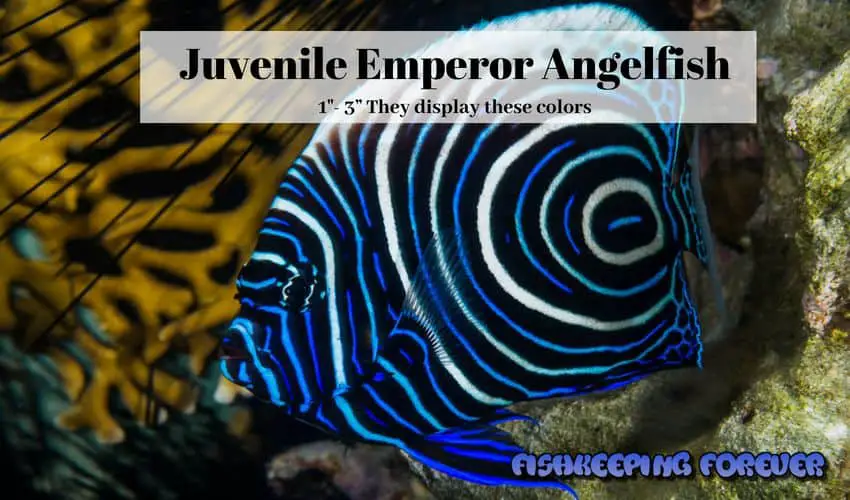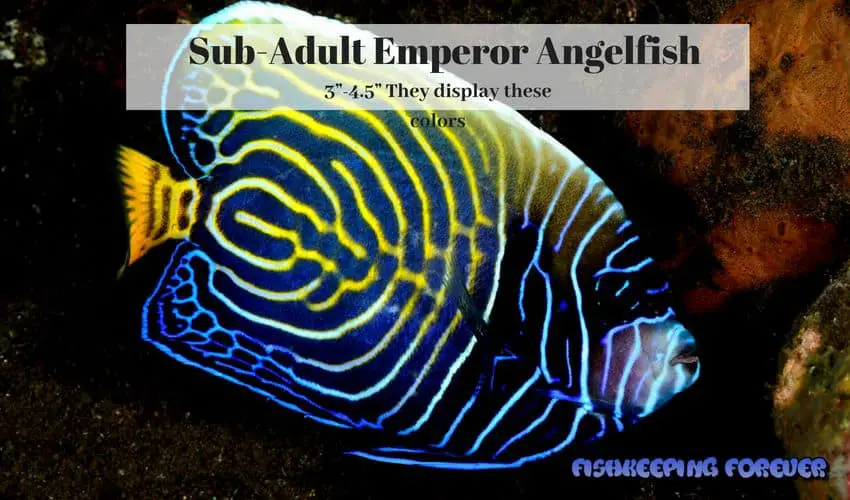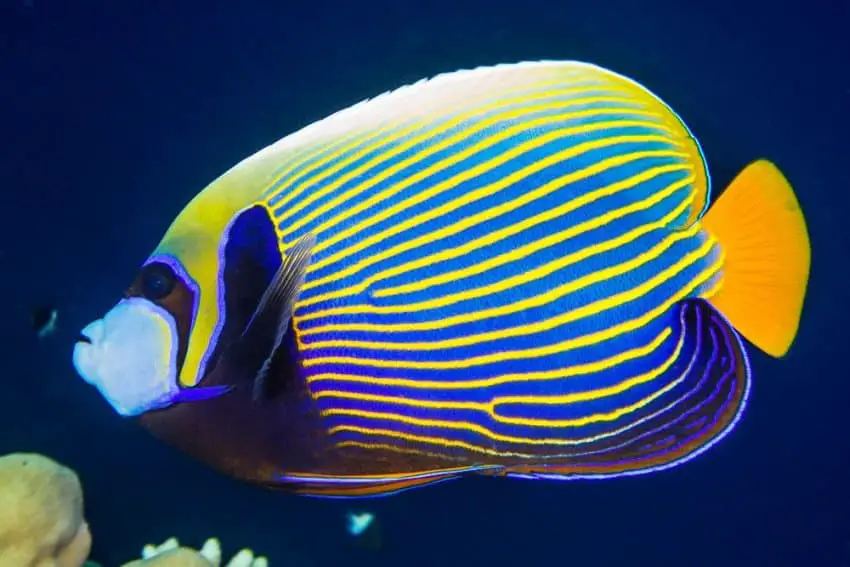The Emperor Angelfish (Pomacanthus imperator) has long been thought of as one of the most desirable saltwater fish for any aquarist to own.
It’s not surprising when you see a fully grown adult in full color, they are simply stunning.
Their colors and patterns change from a Juvenile size fish and then again when it becomes a sub-adult (In between juvenile and adult age). They finally reach their full magnificence at around 5-6″.
Before 1933 people thought that the Juvenile version of the Emperor Angelfish was a totally different species of fish altogether. It was only once this fish was kept in captivity that they witnessed it changing color; as it grew that they realized that it was one and the same fish.
Not long ago, these fish commanded a very high price and were only available to a select few people who could afford one. Recently they have dropped in price and more of these stunning fish are being imported. This has brought the price down considerably.
Now they are affordable, are they suitable for your aquarium?
Let’s look at amazing Emperor Angelfish in more detail and see if they are suited to your home aquarium.
| Scientific Name | Pomacanthus imperator |
|---|---|
| Family | Pomacanthidae |
| Care Level | Moderate |
| Size | Juvenile 1”- 3” Adults 12-14" |
| Diet | Omnivore |
| Temperament | Semi-aggressive |
| Origin | Fiji, Indonesia, Maldives, New Caledonia, Sri Lanka, Vanuatu,Africa |
| Tank Size | 200+ Gallons |
| Water Conditions | 73-78° F, dKH 8-12, pH 8.1-8.4, sg 1.020-1.024 |
| Desirability Level | High |
| Jumpers | Only when first introduced into the aquarium |
| Good First Fish | No-Due to size of aquarium needed and dietary requirements |
| Food Types | Flake, Live foods, Veggi Strips, Marine Pellets |
| Reef Safe | No- Larger fish will eat corals and invertebrates. |
| Lifespan | In captivity 15-18 Years in the wild 20 Years |
| Cost | Juvenile from $99 Adults from $300 |
Table of Contents
Where do Emperor Angelfish come from?
The origin of the Emperor Angelfish ranges from coastal East Africa right through to the Indian Ocean and Pacific ocean.
They have even been seen as far as Southern Japan as well as in the great barrier reef. There are also reports from divers that this fish lives in the Hawaiian Islands, Florida and even Puerto Rico.
These fish are not on the IUCN Red List of endangered fish and are breeding in large numbers. They are classed as ‘Least Concerned’, which means there are no concerns about their immediate numbers in the wild.
Juvenile fish can be found living in and around the outer edges of coral reefs where adult fish can be found venturing further out into open water.
Adult fish are very territorial and have even been known to attack divers who get too close. Fully grown males have a large territory area of around 10,000 square feet which they share with two or more females.
Both juveniles and sub-adults act as cleaner fish, and large males will also clean other much larger fish from time to time.
Emperor Angelfish appearance and colors
The appearance of the Emperor Angelfish will dramatically change over the course of its lifetime. Juveniles are dark blue with white and electric blue rings.
At 24-30 months they start to change appearance and become the amazing masked beauty that we all love.
Their mouth is white and they have a striking blue-black band (Mask) that covers their eyes and a similarly-colored vertical band extends from the pectoral fin two-thirds of the way up the body. This band is highlighted in a sapphire-blue in front, and bright yellow, caudally.
Full adult size is about 40 cm (16 in) in length in the wild. At this size, this fish commands a high price.
Unless you have a very large tank of around 300+ Gallons then we would always recommend buying a juvenile and raising them into adulthood.

This way the fish will be acclimatized to their environment. Adding a large male into an established tank can lead to fights and your lovely Angelfish becoming distressed. However, in a very large tank with plenty of rocks and caves, this shouldn’t be an issue. As long as they have somewhere to hide and retreat.
In the home aquarium, even a large one, you may not be lucky enough to see their true beauty. Unfortunately, the colors on a fully grown adult fish in a fish tank will never be as striking as they are in the wild.
They are still amazing fish but their colors just simply are not as bright in captivity.
Depending on the origin your Emperor came from will contribute to the color. Sri-Lanka-emperor angelfish seem to have some of the brightest colors in a captivity.
Juvenile Small: 1″ to 3″ Will show juvenile colors and patterns
Sub-Adults: 3″ to 4.1/2″ Will start to change appearance and colors
Adult Large: 4.5″ ” to 12″ Will display adult colors and patterns
(These sizes and patterns can vary depending on tank lighting, water conditions, and tank size)
In captivity, you would expect this fish to reach a maximum size of 12-13″ they never reach their full size in captivity.
What size aquarium will you need?
A tank of 220 Gallons minimum will be required for this fish as they can grow to 12-13″ after 4-5 Years.
Provide plenty of live rocks for them to nip and eat and lots of caves and hiding places. In the wild, they spend most of their time eating small invertebrates, plants, and sponges and darting in and out of caves looking for food.
Excellent water quality must be kept at all times. Ensure that water conditions are kept between 72-82oF (22.2-27.8oC) with a pH of 8.1-8.4 and a specific gravity of 1.020-1.025.
Partial and regular water changes are a must and good filtration and strong current are advised. We like the Marine Maxi-Jet wave maker which are available from Chewy.com, an online aquatic supplier, as it’s inexpensive and reliable.
This will create a strong current to emulate their natural water conditions. I purchased mine from Amazon, the link has been attached to make it easier for you. Ensure good levels of oxygenation, this is very important for these fish.
Caves are an important part of making the Emperor Angelfish feel at home. They love big dark caves to hide inside.
Taking care and providing the best conditions for your fish are all part of being a responsible fishkeeper. If you cannot provide a larger tank once this fish reaches adulthood then I would recommend not purchasing one.
We have a responsibility to these beautiful fish and you need to think about the long-term needs of any fish or indeed animal we keep in captivity.
What’s the best food for Emperor Angelfish?
It will be impossible to provide the same variety of diet in captivity as this fish gets in the wild. But every effort and expense should be used to try and give them the best possible variety of foods.
Feed them foods like Spirulina, marine algae, Dried Flake and Frozen meaty foods, brine shrimp, cockles, Krill, mussels, and other finely chopped meaty foods.
Mine loved to be hand-fed algae strips, I purchased mine from Amazon. I have provided a quick link here. There is no better feeling than hand feeding an adult emperor angelfish. I used Ocean Nutrition Seaweed Strips from Chewy.com, one of the largest aquatic online retailers.
Some people provide some nice pieces of living rock for them to nip at and feed off. This will provide a variety in their diet but can be a very expensive feeding option. These rocks contain lots of living creatures that will help their diet.
You have a better chance of your fish accepting dried foods if you have raised your fish from Juvenile stage through to adulthood. Adding a fully grown male and then expecting them to eat dried foods straight away is a challenge.
These fish have a huge appetite and may become aggressive when feeding and often bully other fish out of the way. So make sure all other fish in your tank get adequate food also.
Don’t overfeed your fish, this is the number one reason for poor water quality.
Are Emperor Angelfish Reef Safe?
No, Emperor Angelfish will eat most soft corals and also Shrimps: Best kept with equally large fish and other semi-aggressive marine species.
Emperor Angelfish love to nip and eat live rocks, so even adding them into a tank with purely live rocks and no invertebrates, can lead to damage to your decor.
They will easily chew up rocks and make short work of anything living in or on the rocks.

In a reef tank, most Angelfish will nip at large polyp stony corals (LPS), anemones, zoanthids, clams and some soft corals. If you have a very large tank with small polyp stony corals (SPS) and some noxious soft corals, and your angelfish is well fed, they may leave them alone.
But don’t take our word on that! This amazing Angelfish has a feeding menu all of its own and only he/she knows what it wants to eat from one day to the next.
One thing is for sure, it will eat
Suitable tank mates for Emperor Angelfish
Emperor Angelfish are very territorial and a little boisterous at feeding time. Therefore you will need to ensure that other fish in the tank can withstand their semi-aggressive behaviors.
These are large fish and need to be housed with other big saltwater fish. Anything too small will be a target for this Angelfish.
Suitable tankmates would be Pufferfish, Large Tangs, Cleaner Wrasse, larger Rabbitfish, Surgeon Fish, Snowflake ells Trigger Fish lionfish.
Smaller fish like Gobies are not always a bad choice to keep with these big fish as long as they are fast-swimming species that have hiding places, holes and caves they get to escape into if they feel threatened by your emperor angelfish.
Emperor Angelfish Lifespan
The emperor Angelfish had a lifespan of 15 Years in the wild. In the home aquarium it’s more like 12-13 Years as often the size of the aquarium is not suitable for an Adult fish.
Emperor Angelfish Care Guide
Juveniles are sometimes mistaken for the Koran Angelfish as they both display similar colors and patterns.
Sub-Adults is a term used to describe these fish when they are in between the juvenile stage and adulthood. Their patterns change from the dark blue and stripy patterns to the amazing yellow and blue fish we all know and love.
Occasionally, juvenile fish do not fully develop the adult colors and markings in captivity. This is rare if the conditions and tank size are adequate. Poor water quality, diet and tank size is the overriding factor for lack of colors in captivity. Offering a varied and suitable diet will help this fish retain the vivid colors and avoid head and lateral line erosion (HLLE). Strong lighting also helps prevent Head and Lateral Line Erosion.
In the wild, both juvenile and adult fish will act as cleaner fish, the adults can often be seen cleaning much larger fish. However, in a home aquarium, this is not seen as much due to the fact that adult emperor angelfish are normally one of the largest fish in the tank. Juveniles may still act as cleaner fish in a home fish tank but adults will only clean larger fish predominantly.
Keep only one specimen per tank, and not with any other angelfish unless you are lucky enough to own a very, and I mean a very large tank.
Never keep this species of fish with invertebrates or small, passive fish. They have been known to wipe out a tank of invertebrates within weeks.
This species has never been bred in a home aquarium. There have been reported cases of them breeding in public aquariums and zoos but not in a home aquarium.
Conclusion: Emperor Angelfish Care Guide
Should you buy one of these fish? Well, YES. If you have the right environment and tank conditions, then why not. They are truly amazing fish to keep and will certainly be the main attraction in your fish tank.
Every saltwater fishkeeper either wants one of these fish or has kept one in the past. They are a wonderful addition to any marine fish tank.
Let us know if you have one of these or planning to buy one. What do you love about the Emperor Angelfish and what challenges did you face keeping them.
Happy Fishkeeping.
[author title=”About the Author”]

I have been working in the tropical fish industry for over 30 years now and I’m still learning. Everyday is a school day in this hobby. In my spare time I play golf very badly!


